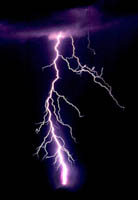Lightning (storm data, deaths, lightning myths, and safety tips)

Zeus, park rangers, and the probability of being struck by lightning
by Borgna Brunner
 Lightning LinksDon't Become A StatisticHere are a few things to bear in mind if you don't want to become a victim of a "fiery flaming thunderbolt," as Homer called Zeus's favorite weapon:
|
Zeus, the Greek king of the gods, punished wayward mortals and miscreant gods by hurling thunderbolts at them. Sky deities from many world religions, including Zeus's Roman counterpart Jupiter, the Germanic Thor, the Mayan Chac, and the Slavic Perun, all used the thunderbolt as the paramount symbol of power.
Whether deserving the wrath of the gods or not, chances are slim that you'll meet your end from a bolt of lightning. Lightning causes only an average of 49 deaths and 300 injuries in the United States each year. The National Weather Service publication Storm Data recorded a total of 4,049 deaths—the most of all the severe weather categories—between 1959 and 2014. In 2014, there were 26 lightning fatalities in the U.S.
Dead Ringers
Whatever your strategy for avoiding lightning, be sure to stay clear of church bells. During the Middle Ages, their ringing was believed to diffuse lightning, and many medieval bells were engraved with Fulgura frango ("I break up the lightning"). This suspect theory was discredited by a medieval scholar who observed that over a 33-year period, there were 386 lightning strikes on church towers and 103 fatalities among bell ringers.
Shocking Humor
Should you live to tell the tale of being struck by lightning, you can join the Lightning Strike and Electric Shock Survivors International, Inc. (LSESSI), a non-profit support group for such survivors. With its motto, "Join us if it strikes you," and newsletter, Hit or Miss, the group emphasizes the necessity of a sense of humor in overcoming trauma.
One LSESSI member has been victimized both indoors and outdoors. The record holder, however, is Roy C. Sullivan, an ex-park ranger who survived seven different lightning strikes. According to the Guinness Book of Records, Sullivan was first hit by lightning in 1942, which caused him to lose his big toenail. Over the next 35 years, lightning burned off Sullivan's eyebrows, seared his left shoulders, set his hair on fire, struck his legs, injured his ankle, and burned his stomach and chest.
Safe Spots
The safest place to be during a thunderstorm is in a building, preferably one with a lightning rod. The rod offers protection by intercepting lightning—an electrical charge—and transmitting its current into the ground. Made out of metal so that it conducts the charge, it is usually located as high as possible because of lightning's tendency to strike the nearest object to it. (And yes, Benjamin Franklin did invent the lightning rod, as well as prove that lightning was actually electricity through his flying-a-kite-during-a-thunderstorm experiment.)
The other safe place is a car with the windows rolled up, as long as you don't touch any of the metal parts. If lightning strikes, the car's metal body will conduct the charge down to the ground—contrary to popular belief, the rubber of the wheels offers no protection.
